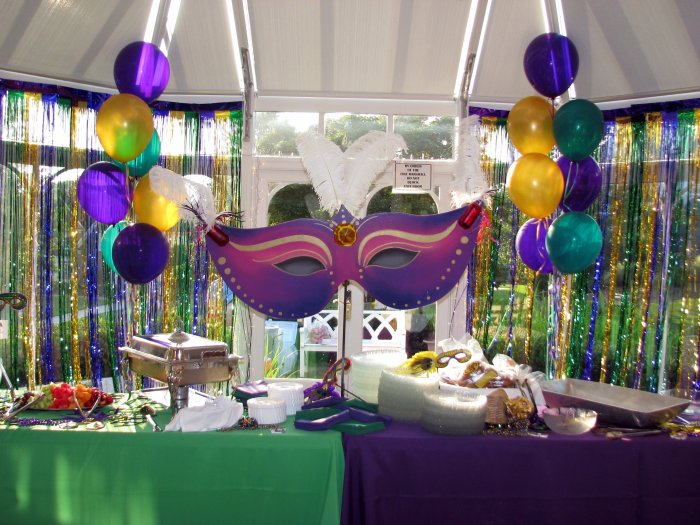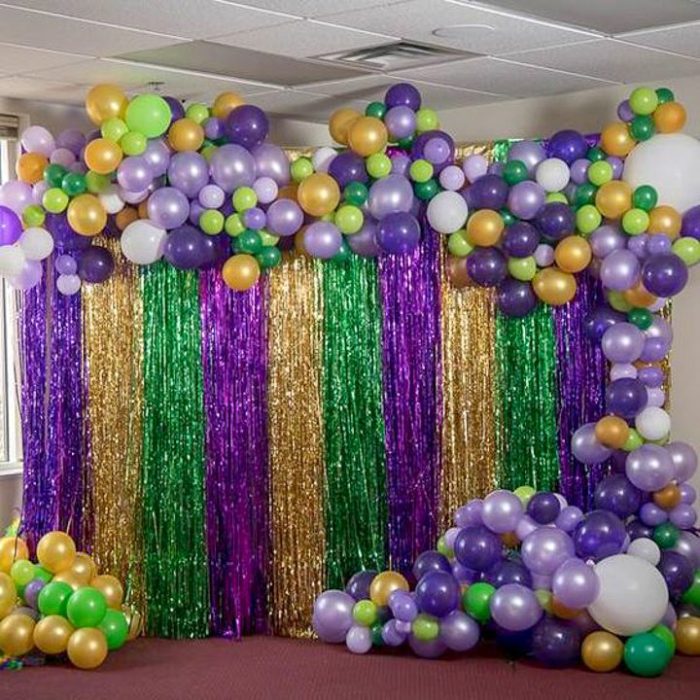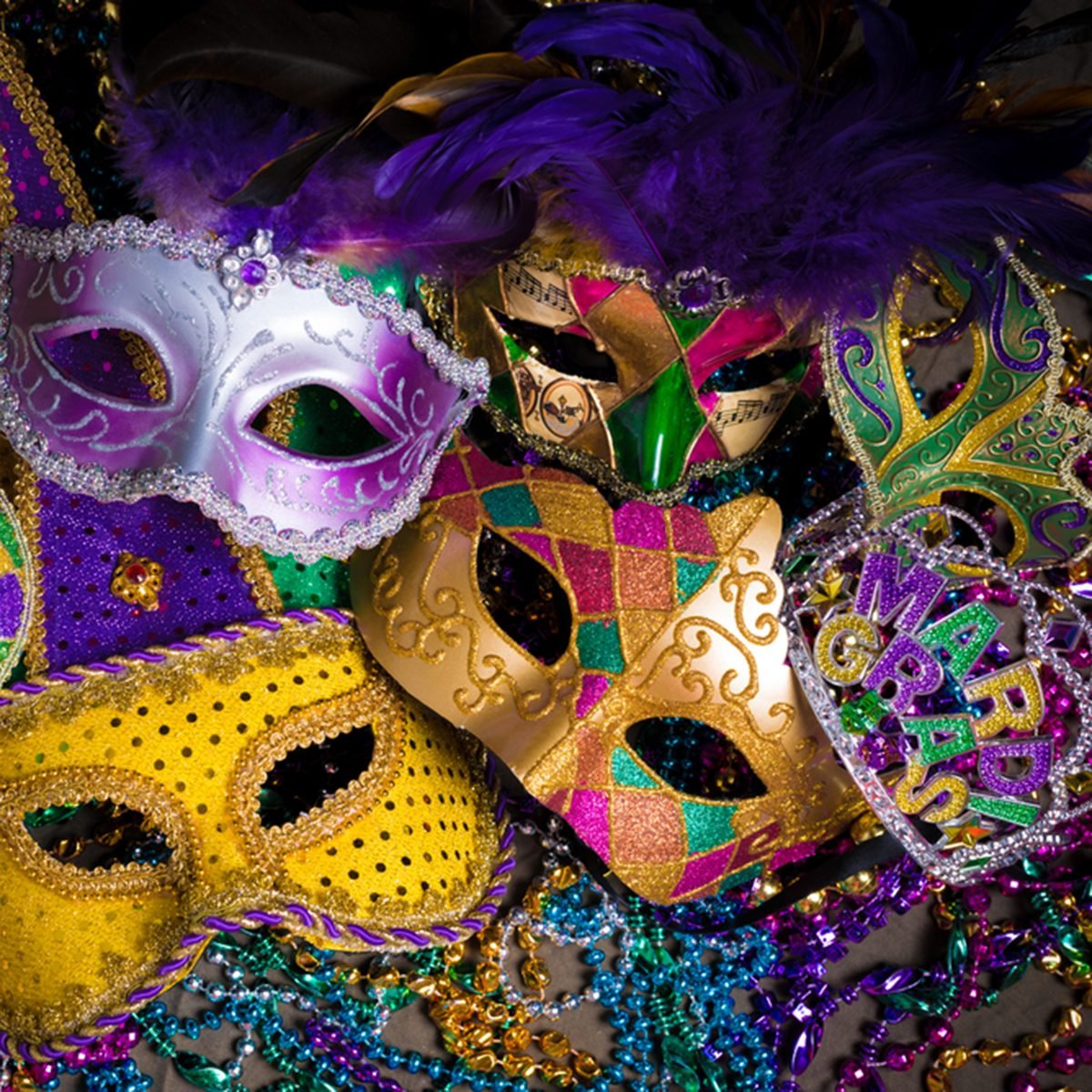Mardi Gras Decor: More than just beads and masks, the vibrant decorations of Mardi Gras tell a rich story of cultural fusion and artistic expression. From the historical evolution of its iconic symbols to the contemporary interpretations seen in parades and celebrations worldwide, the visual tapestry of Mardi Gras offers a captivating journey through time and tradition. This exploration delves into the history, symbolism, and creation of these festive adornments, showcasing their significance in both local communities and popular culture.
We’ll uncover the origins of the traditional purple, green, and gold color scheme, examining their symbolic meanings and regional variations. We’ll also explore the diverse types of Mardi Gras decorations, from intricately crafted masks and dazzling floats to the ubiquitous beads and throws, analyzing their materials, production methods, and cultural importance. Finally, we’ll look at the economic impact of this vibrant industry and how Mardi Gras decorations continue to evolve in popular culture.
Types of Mardi Gras Decorations

Mardi Gras decorations are integral to the vibrant celebration, transforming streets and venues into a spectacle of color, sound, and cultural expression. These decorations are more than mere embellishments; they represent the rich history, traditions, and spirit of the Carnival season. Understanding the various types of decorations and their symbolism provides deeper insight into the celebration’s significance.
Mardi Gras decorations encompass a wide range of items, each contributing to the overall festive atmosphere. Key categories include masks, beads, throws, costumes, and floats, each possessing unique characteristics and cultural meanings.
Mardi Gras Masks
Mardi Gras masks are more than just accessories; they symbolize anonymity and revelry. Historically, masks allowed individuals to shed their everyday identities and embrace a spirit of uninhibited fun and social interaction. The designs vary widely, from simple, colorful masks to elaborate, handcrafted pieces depicting characters from mythology, history, or popular culture. Materials range from paper mache to feathers and beads, reflecting the diverse artistry involved in their creation.
The symbolism is rooted in the tradition of anonymity, allowing for playful interactions and a temporary escape from societal norms.
Mardi Gras Beads
Beads are arguably the most iconic Mardi Gras decoration. These brightly colored strands, often made of plastic, are tossed from floats to the crowds below. While seemingly simple, the act of catching beads is a cherished part of the Mardi Gras experience, signifying participation and good fortune. The colors themselves often hold symbolic meaning, with purple representing justice, green representing faith, and gold representing power.
The sheer volume of beads thrown emphasizes the abundance and generosity associated with the celebration.
Mardi Gras Throws
Beyond beads, a variety of other items are thrown from floats, collectively known as “throws.” These can include stuffed animals, cups, coins, and even small toys. Like beads, catching a throw is considered lucky, and the variety of items adds to the excitement and unpredictability of the parade. The act of throwing itself represents a sharing of the festive spirit and a connection between those on the floats and the spectators.
The diverse nature of throws reflects the inclusive and exuberant nature of the celebration.
Mardi Gras Costumes
Costumes are essential to the Mardi Gras experience, allowing participants to embody characters and themes related to the celebration. From elaborate, historically-inspired costumes to whimsical and creative designs, costumes enhance the visual spectacle and embody the spirit of playful self-expression. The creativity and effort invested in costumes reflect the dedication and passion of the participants, further enriching the overall experience.
The costumes themselves can represent a wide range of characters and themes, reflecting the diversity of cultural influences within the celebration.
Mardi Gras Floats
Floats are the centerpiece of Mardi Gras parades, serving as majestic, moving displays of artistry and craftsmanship. These elaborate structures, often depicting themes or stories, are meticulously designed and decorated, showcasing a wide range of artistic skills and technical expertise. The floats represent the culmination of months, even years, of planning and preparation, demonstrating the dedication and community involvement integral to the celebration.
The themes depicted on the floats often reflect current events, historical narratives, or popular culture, making them a dynamic and evolving aspect of the celebration.
Comparison of Mardi Gras Decoration Types
| Type | Materials | Production | Significance |
|---|---|---|---|
| Masks | Paper mache, feathers, beads, plastic | Handcrafted, mass-produced | Anonymity, revelry, artistic expression |
| Beads | Plastic, glass | Mass-produced | Good fortune, abundance, generosity |
| Throws | Stuffed animals, cups, coins, toys | Mass-produced, handcrafted | Luck, sharing, connection |
| Costumes | Fabrics, accessories, embellishments | Handcrafted, purchased | Self-expression, character embodiment, cultural representation |
| Floats | Wood, metal, papier-mâché, paint, decorations | Intensive craftsmanship, team effort | Artistic expression, storytelling, community involvement |
Typical Mardi Gras Decoration Arrangement
Imagine a vibrant tableau: Purple, green, and gold streamers cascade from balconies and lampposts, creating a canopy of color. Below, the streets are alive with the glittering spectacle of tossed beads, their iridescent hues reflecting the sunlight. Elaborate masks peek from behind the revelers, their expressions hidden yet hinting at the joyous abandon of the celebration. A large, ornate float, adorned with vibrant colors and intricate details, makes its slow, majestic procession down the street, showering the crowd with more beads and throws.
The overall effect is a dazzling, multi-sensory experience, a testament to the rich cultural heritage and vibrant spirit of Mardi Gras.
Color Schemes and Symbolism in Mardi Gras Decorations

The vibrant colors of Mardi Gras are more than just aesthetically pleasing; they hold deep symbolic meaning, contributing significantly to the overall festive atmosphere. The traditional color palette, consistently used across the celebrations, provides a visual language understood by participants and spectators alike. This section will delve into the significance of these colors, explore regional variations, and compare their usage with other global celebratory traditions.The primary colors of Mardi Gras – purple, green, and gold – represent justice, faith, and power, respectively.
Purple symbolizes justice, representing the struggle for equality and fairness. Green signifies faith, embodying hope and the belief in a brighter future. Gold represents power, symbolizing the strength and majesty of the royalty and the spirit of the celebration. These colors, woven into costumes, floats, beads, and other decorations, serve as a constant visual reminder of the core values associated with the festival.
Regional Variations in Mardi Gras Color Schemes
While the purple, green, and gold triad is universally recognized as the core Mardi Gras color scheme, subtle variations exist across different regions and even individual Krewe celebrations. Some groups might emphasize certain colors more prominently, incorporating additional shades or hues to reflect their unique themes or traditions. For example, a Krewe focusing on a specific historical period might incorporate colors representative of that era, while others might use color variations to express a more modern interpretation of the Mardi Gras spirit.
These variations, however, rarely deviate significantly from the traditional palette, ensuring the overall visual identity remains consistent with the broader celebration.
Color’s Role in Creating Mood and Effects
The strategic use of color significantly impacts the overall mood and visual impact of Mardi Gras decorations. The richness of the gold, for instance, evokes a sense of opulence and grandeur, often seen in the elaborate beadwork and float designs. The vibrant green instills a feeling of life, renewal, and growth, mirroring the spirit of rebirth often associated with springtime festivals.
The regal purple adds a touch of sophistication and solemnity, reflecting the historical roots and social significance of the celebration. The interplay of these colors, combined with lighting and other decorative elements, creates a dynamic and immersive visual experience.
Comparison with Other Celebratory Decorations Worldwide
The symbolic use of color in Mardi Gras decorations finds parallels in other celebratory traditions worldwide. For example, the vibrant reds and golds common in Chinese New Year decorations symbolize prosperity and good fortune, while the bright hues of Holi, the Hindu festival of colors, represent joy, renewal, and the triumph of good over evil. Similarly, the use of specific colors in national flags and other symbolic representations often holds deeper cultural significance.
However, the unique combination and symbolic meaning attributed to purple, green, and gold remain distinctly associated with Mardi Gras, making it a visually recognizable and culturally significant celebration.
DIY Mardi Gras Decorations

Creating your own Mardi Gras decorations is a fun and rewarding way to personalize your celebrations and embrace the spirit of the festival. This allows for unique expressions of creativity, often resulting in more meaningful and memorable decorations than store-bought options. Furthermore, crafting your own decorations can be a cost-effective and environmentally conscious alternative, allowing you to utilize recycled materials and reduce waste.
DIY Mardi Gras Masks
Creating Mardi Gras masks is a relatively simple process, perfect for both beginners and experienced crafters. These masks can range from simple designs to elaborate creations, depending on your skill level and available materials. The beauty lies in the freedom to personalize each mask with unique colors, embellishments, and patterns.
- Materials: Cardstock or construction paper, scissors, glue, paint, glitter, feathers, ribbons, elastic cord or string.
- Instructions: First, draw a mask shape onto your chosen material. Cut out the shape carefully. Then, decorate the mask with paint, glitter, feathers, ribbons, or any other embellishments you desire. Finally, attach an elastic cord or string to the sides of the mask for wearing. Consider using stencils for more intricate designs or incorporating found objects like buttons or beads.
DIY Mardi Gras Beads
While traditionally purchased, Mardi Gras beads can easily be made at home using recycled materials. This provides a sustainable approach to crafting, reducing reliance on mass-produced plastic beads. Homemade beads can also offer a unique, personalized touch.
- Materials: Recycled plastic bottles (cleaned and cut into strips), hot glue gun, paint, glitter.
- Instructions: Cut clean plastic bottles into thin strips. Using a hot glue gun, carefully glue the strips together to create bead shapes. Once the glue is dry, paint and decorate the beads with your chosen colors and glitter. String the finished beads onto a strong cord or string to create a necklace or garland.
DIY Simple Mardi Gras Float Elements
Even without building a full-scale float, you can create miniature float elements to decorate your home or party space. This allows for smaller-scale projects, perfect for incorporating children or for those with limited space. These elements can easily be adapted to reflect your own unique Mardi Gras theme.
- Materials: Cardboard boxes (various sizes), paint, glue, craft foam, tissue paper, recycled materials (bottle caps, etc.).
- Instructions: Begin by shaping cardboard boxes into desired forms – perhaps a small fleur-de-lis, a jester’s hat, or even a simplified representation of a king cake. Cover the boxes with paint and decorate with craft foam, tissue paper, and recycled materials. For example, bottle caps can be painted gold and used to simulate jewels.
From its humble beginnings to its current status as a global spectacle, Mardi Gras Decor reflects a vibrant tapestry of cultural influences and artistic creativity. Understanding the history, symbolism, and craftsmanship behind these decorations enriches the Mardi Gras experience, allowing us to appreciate the artistry and cultural significance woven into each bead, mask, and float. Whether you’re a seasoned Mardi Gras enthusiast or a curious newcomer, the world of Mardi Gras decoration offers endless fascination and inspiration.
The vibrant colors, intricate designs, and rich symbolism create a truly unforgettable visual feast, embodying the spirit of celebration and community that defines this unique festival.